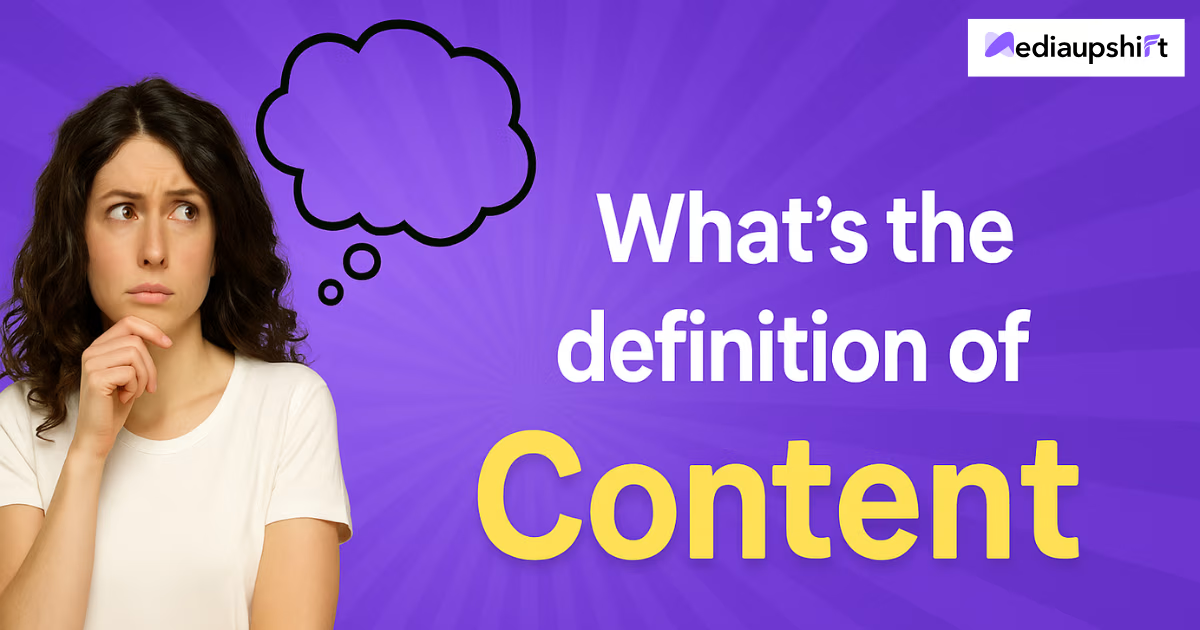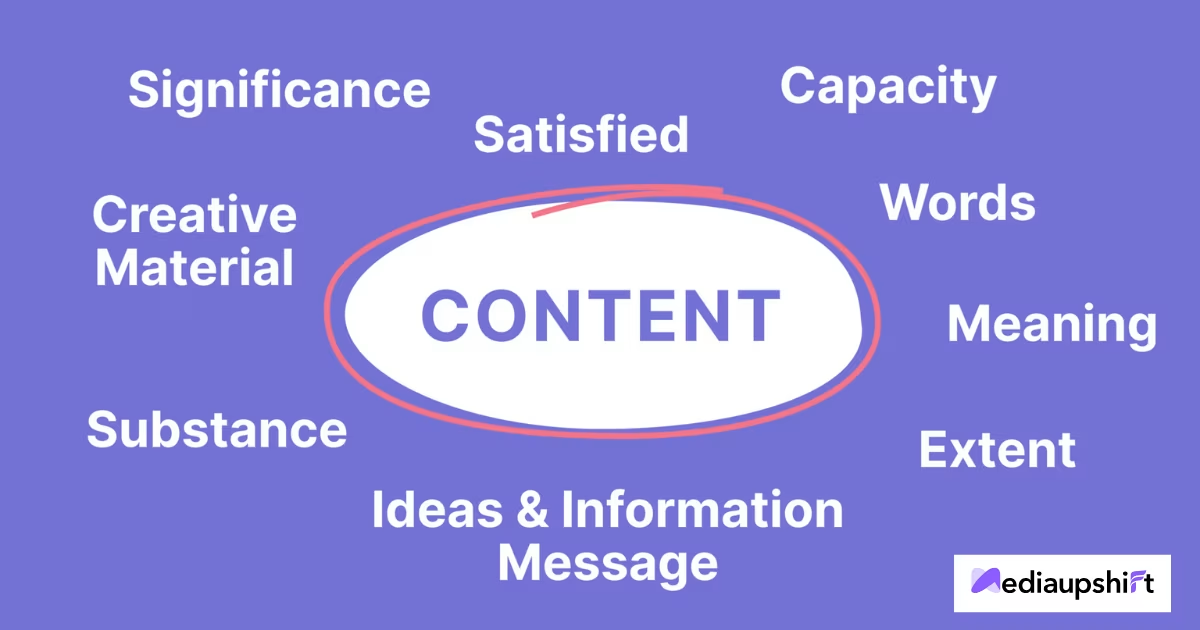What’s the Definition of Content?
Published on: 29 Oct, 2025

“Let’s create some content”
“Share your content”
“That’s viral content!”
We hear this word everywhere. But do you ever just stop and wonder what exactly is content?
It's mostly everywhere, blog posts, YouTube videos and even the text you’re reading right now – this is all content. But the actual meaning of content is far beyond just these online posts or entertainment. It’s a word that’s evolved with time and blended communication, creativity, and purpose into one single concept.
In this blog, we’re discussing what content is by definition and learning what it truly means in English and writing, and where it stands in marketing today. And by the end, you’ll never see content the same way again.
What Is Content?
Before we dive straight into marketing buzzwords, let’s start with basics and see what the dictionary says. Interestingly, content isn’t just one thing. It has multiple meanings depending on the context. Let’s go through them all to understand how this small word holds so much meaning.
Definition 1: Things Inside
In the simplest form, content refers to what’s inside something.
For example:
- The content of a book will be the text inside it.
- The content of a bottle will be the liquid it holds.
So, when we say “content,” we’re actually talking about any substance or material that is filling or contained in something.
Think of it as the stuff that fills the space. This meaning is quite literal here but it also lays the foundation for deeper interpretations that we can use today.
Definition 2: Subject or Topic
In another sense, content can refer to the subject matter of what something is about.
Example: “The content of this speech focuses on mental health awareness.”
Here, it’s not about the physical things but rather the information or a message being delivered. This meaning is mostly used when you are writing and communicating and where the focus is on ideas and meanings.
Definition 3: Chapters List or Material in a Book
You’ve seen the ‘Table of Contents’ at the start of books, right? That’s another place where it's used. It represents the organized list of sections or chapters included in the book. It’s made in such a way that helps you navigate through the book easily.
Definition 4: Program or Entertainment Material
When we say “online content,” we mean anything that is designed to inform, educate, or entertain you like the blog posts, videos, reels, podcasts, memes, or even tweets.
So when someone is saying that “I create content”, they mean they produce something that people consume or watch online and it can be for fun, learning, or inspiration.
Definition 5: Substance or Essence
Another definition points to content as the essence or core value of something.
Example: “The content of her message was full of hope.”
Here, the word refers to meaning, depth, and significance and not just what’s being said, but why it matters.
Definition 6: Ratio or Measurement
In scientific or technical contexts, content can also mean the amount of a particular element within a whole.
For example:
- Water content in soil.
- Protein content in food.
It’s all about measuring the quantity of a specific component. So from liquids to language, content truly wears many hats.
What Is Content (Or What Should Be Meant by It)?

Now that we’ve seen the dictionary meanings, let’s get to the real question – what is content in modern times? If we put it simply, content is any piece of information which you write to rank and that is created to communicate or indicate a message to get a response. That could be a heartfelt caption, a blog post, a funny video, or even a brand’s ad campaign. The purpose remains the same, which is to connect, inform or inspire.
When people ask “What do you mean by content?” or “What is the meaning of content in English?” The simplest explanation could be that content is the bridge between information and emotion that turns data into stories, and words into experiences.
Information Is the Key
Every type of content carries information but great content doesn’t just share facts, it tells them in a way that connects. That’s why, when it comes to content writing in SEO and its meaning in writing, clarity and relatability is what matters most. It's about giving your audience something valuable which makes them think, feel, or act.
Content Marketing
This is where it all comes together. Content marketing is an approach of using valuable and relevant content to attract and gain an audience. Not with hard selling, brands use content to build relationships through blogs, videos, emails, and social media posts. The websites are also tweaked with on-page optimization that brings you engagement. For example, a brand may post “how-to” guides or tutorials which are not to sell directly, but to earn trust. That’s what makes content marketing one of the most powerful tools in digital business today.
What Are the Basic Types of Content in Marketing?
Let’s explore the most common types of content marketers use, and how they work.
1. Blogging
Blogs are the most important part of content marketing. This is what educates, engages, and helps in becoming a responsive website that rank higher on Google. A well-written blog post will not only inform but also enhance your visibility to build a certain level of trust with the audience.
2. Newsletter E-mails
Newsletters are like friendly reminders that keep your brand in people’s inbox and their mind. This will help you share some updates, deals, and valuable tips which is perfect for customer retention.
3. Case Studies
Case studies tell real stories of any product or service. They show how a brand and their product/service solved a problem for clients, and that is proof of expertise and reliability.
4. Videos
Video content dominates the internet from tutorials to vlogs to brand stories. It’s engaging, easy to consume, and perfect for today’s fast-scrolling audience.
5. Social Media
Social platforms like Instagram, TikTok, and LinkedIn are content goldmines. They help brands engage, entertain, and stay visible through short-form posts, reels, and graphics.
6. User-Generated Content (UGC)
UGC is content created by real users where you do influencer collaborations to make reviews, testimonials, or social posts. It’s authentic and builds credibility better than traditional ads.
7. Infographics
Infographics are visuals that turn complex data into easy-to-read charts or designs. They’re shareable, informative, and ideal for educational posts.
8. Ads
Yes, ads are content too! They’re paid, persuasive messages created to catch attention and drive action, often blending creativity with strategy.
9. White Papers
White papers are in-depth reports or research-based documents used mostly in B2B marketing. They demonstrate authority and provide deep insights into a subject.
Why Content Matters More Than Ever
Content is the foundation of all communication today. Whatever you post on social media to how brands share stories, everything depends on meaningful content. It informs, connects, inspires and most importantly, it drives action.
Without good content, marketing has no voice but with it, you can make people listen.
Conclusion
Content is everything created to express, inform, or connect, whether it’s a tweet, a video, or a 10-page article. It’s how humans share their views and ideas, emotions, and experiences across digital and real-world spaces. The next time you are scrolling through Instagram or reading a blog, or maybe watching a YouTube tutorial, make some time to recognize that what you are watching and reading is not some random stuff, it’s content.
If you want to grow your brand and actually build a strong content base then partner with MediaUpShift, which is the best digital marketing company in Delhi and start your journey today!
Frequently Asked Questions
1. What exactly does the word “content” mean?
Content refers to what’s inside something, like the text in a book or liquid in a bottle. It is also based on different contexts as well. In marketing, it can mean any information that is generated to share a message or inform.
2. What are the main types of content used in marketing?
There are many forms of content that you can use to connect with your audiences. The most common include:
- Blogs - for educating and engaging readers
- Newsletters - for maintaining brand relationships
- Videos - for visual storytelling
- Social Media Posts - for quick engagement
- User-Generated Content (UGC) - for authenticity
3. Why is content so important in today’s world?
Content is the foundation of the modern way of marketing and this helps brands to connect, influence, and drive real action.
4. How is content different from content marketing?
Content is the information or any type of creative material like a blog post, video, or image, but content marketing is the strategy that you make to use that material to attract and engage an audience.